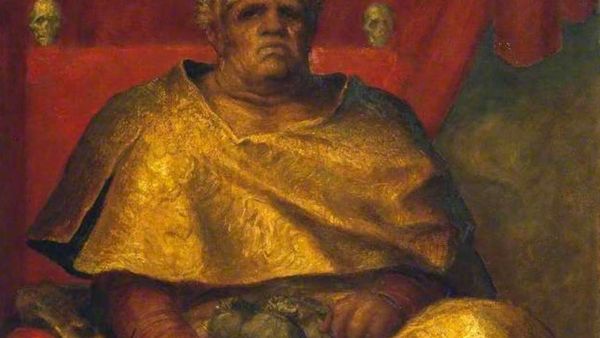The observation of this year’s Lent finds the world under an unprecedented global quarantine. A coincidence of course, but a coincidence that might be meaningful perhaps, as coincidences often are for those who observe them.
We think of a quarantine as a confinement in space and as the name for the room or the building in which such a confinement takes place. Yet, quarantine is the name for a duration, a number of days. The word derives from the Italian expression quaranta giorni—that is, a period of 40 days during which any ship sailing to Venice had to remain moored away from the city’s port as a precaution against the plague. A quarantine, therefore, is first and foremost a temporal category, a mark of time, and only secondarily of space. In fact, the quaranta giorni spent in Venice (and I am here reminded of a later quarantine in Venice as told by Thomas Mann) borrows its name and its meaning from the 40 days of Lent (Quadragesima). Lent is still the number of 40 days in Italian and French (la Quaresima and le Carême respectively).
Every Lent is a quarantine. For the practices observed during Lent meant to place the world and our daily interactions with the world and with others under suspension. We call that suspension fasting. To fast is to abstain primarily from food—since digestion is our main connection with the world and the exemplar of all the ways in which we relate to the world and to others—and, subsequently, from any other habit that attaches us to the world. By detaching us from the world, either literally or symbolically, fasting allows us to look at and reflect upon the world. Detachment is a necessary condition for such reflection. For as long as we are attached to the world, we remain bound to it by a double bind: the more we occupy the world and we let ourselves be preoccupied by our worldly affairs the more difficult it becomes for us to understand what it means to live in the world. Fasting introduces a distance between ourselves and the world—the very distance that allows us to look and reflect upon the world and our worldly existence.
The quarantine of the coronavirus pandemic has forced upon all of us that distance. For the first time, Lent is “observed” by the entire world. A Lent pandemically observed offers a rather different and somewhat unorthodox appraisal of the new reality that has emerged around the globe.
I do not suggest that we should rejoice amidst the ever-rising number of infections and fatalities on account of some vague “spiritual” benefit. On the contrary. Rather, I suggest that there might be more than one way to contextualize and understand the suffering that is the result of this ongoing crisis. To read the quarantine within the context of Lent—a reading invited by the very fact that they coincided—is to avail of a richer vocabulary that derives from certain Biblical narratives (e.g., Israel’s 40 year wandering in the desert; the 40-day fasting of Moses and Elijah) and thus to connect our quarantined lives today with the past, to inscribe them within a tradition, in short, to given them a language.
There has been, of course, plenty of talk about the coronavirus, an abundance of graphics and statistics, and a daily dose of reportage from the affected communities. Yet, this remains for now an experience without language. Biological and epidemiological terminology—necessary as it is—remains ineffective in giving sense to our experience of this pandemic and that is because the language of science is abstract but my experience of the dismantling of the world as I knew it remains concrete. Homer’s epic stories and parables have proven more successful in bestowing and communicating meaning to our reality than these abstract definitions and formulae.
Let us take a closer look at how the 40 days of Lent originate from the 40 days that are often mentioned in the Scriptures as a time of preparation for an encounter with the wholly (and holy) Other:
Moses was there with the Lord forty days and forty nights without eating bread or drinking water. And he wrote on the tablets the words of the covenant—the Ten Commandments (Exod 34:28).
And again:
So he [Elijah] got up and ate and drank. Strengthened by that food, he traveled forty days and forty nights until he reached Horeb, the mountain of God” (1 Kings 19:8).
While Moses and Elijah fast in preparation for these theophanies, Christ does so immediately after the theophany that occurs in his baptism at Jordan and in preparation for his public ministry.
Then Jesus was led by the Spirit into the wilderness to be tempted by the devil. After fasting forty days and forty nights, he was hungry (Matthew, 4:1-2).
In retaining the fast of the 40 days the Lord shows the unity and continuity between the two covenants, the Old and the New; yet, by reversing its order and placing his 40 days of fasting after, instead of before, the theophany of his baptism, He shows that, unlike Moses and Elijah, he was not simply one of the Prophets in need of preparation and purification for the encounter with God. Thus, his fasting comes after the revelation at the banks of Jordan, as a preparation that would also lead him to a mountain—spiritual geography is always demarcated by holy mountains—however, his ascent to Golgotha has an entirely different purpose: not to meet God, but rather to be forsaken by God. Yet, like Moses and Elijah, though in a different way, Christ’s passion on Calvary is the moment of his glory.
Through this brief scriptural retrospect, we can come to understand Lent as a symbolic and spiritual ascent to “God’s mountain” (Sinai, Horeb, Golgotha) where we hope, like Moses and Elijah, to encounter God, while remaining mindful that such an ascent can become cruciform—that is, it can take the form of the way of the Cross. In that sense, a Christian’s entire life can be understood as a Lent, during which the Lent we are currently traversing assumes the meaning of the “lengthening” of one’s efforts as a result of which the days become “long” (“Lent” in English derives from the German verb “to lengthen”).
Yet, the days of Lent are numbered. The enumeration of the days reveals to us a different meaning: if we can count them, this is because we could count them down. “40 days” means 40 days-until: an element of expectation and anticipation is already inscribed in the numbering of the days. They are 40 and no more: here one should hear and feel some consolation, for already from their beginning one begins to see their end. For they have an end in both senses: they have an end, that is, there is a point by which they will be over, and they have an end in the sense that they serve as means to that end. In both senses, then, the end of Lent is Easter.
The 40 days before Easter (or better yet, the 40 days until Easter) are like the 40 days after Easter: they belong to Easter. For the Church’s calendar Easter is indeed a big feast, for not only it is celebrated continuously throughout the year on every Sunday, but its proper celebration too becomes the focal point of a long fore-feast and an equally long after-feast which, taken together, amount to almost one-third of the year. The importance allotted to Easter can be explained by, among other things, its function as our East. Easter is our east in the sense that it helps us orient ourselves in time as the geographical east provides our orientation in space. Without such an orientation, time becomes flat. One does not quite know at what time of the year we are. A time that is indistinguishable becomes unbearable and unlivable: not only because it becomes terribly monotonous, but also because without orientation time lacks direction and without direction no action can be undertaken. Temporal disorientation paralyzes man.
Precisely because Lent is a counting-down to Easter it is inevitably a period of alertness. The Bridegroom’s coming is imminent; thus we cannot anymore spend our days in forgetfulness amidst the world. Fasting—the preeminent characteristic of Lent—serves as a practice of reminding: a reminder that comes in the form of a continuous dispossessing of the world. If by eating we integrate the world into ourselves, fasting extricates us from the world. It opens up a space, a distance between ourselves and the world, in which the waiting for the Bridegroom can take place.
This temporary suspension of the world is not motivated by a hatred for the worldly and the secular, nor does it devalue the world, on the contrary; if, for the period of Lent, I suspend my worldly attachments to the world, that is not in order to avoid any moral contamination from it, but rather in order to retrieve and re-enjoy the original joy that the world held for me when I first discovered it.
If the promise of Easter is offered to all, if all nations are invited to partake to victory of life over death, it might be appropriate that we should all travel together the penitential route of this year’s Lent.


